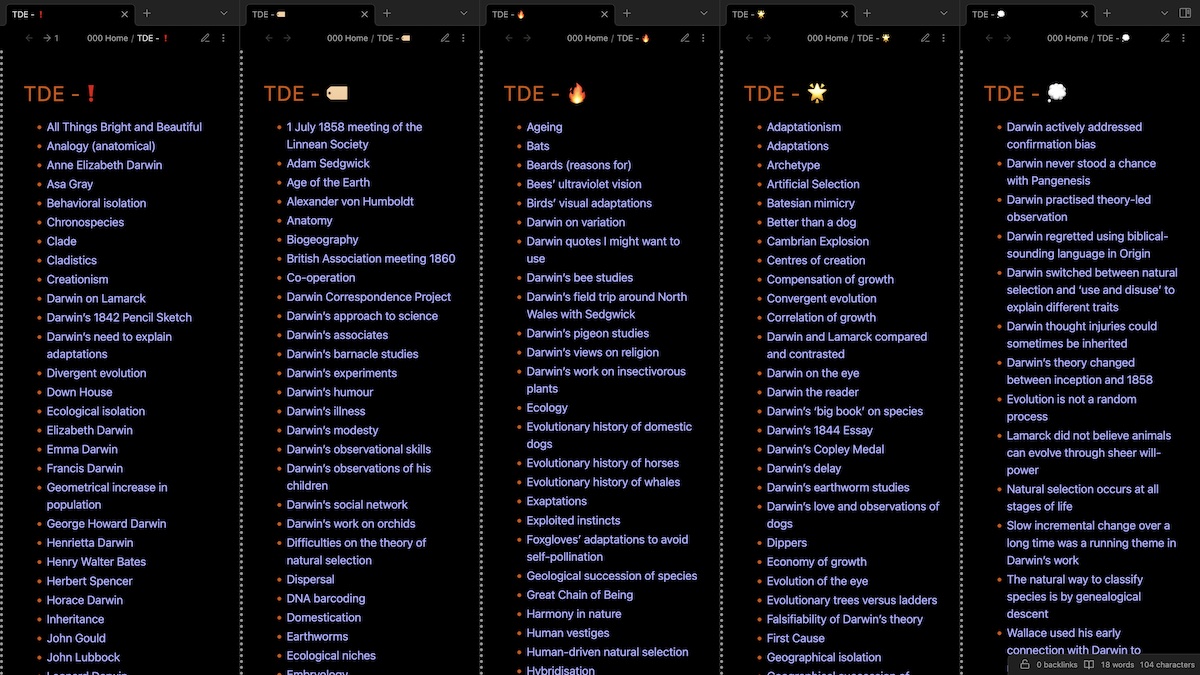For many years, I maintained notes on diverse topics in a number of different places. These included (and, in the first three cases, still include):
- paper notebooks;
- index cards of notes made while reading books (these doubled as bookmarks, and were permanently ‘filed’ inside the book in question);
- collections of electronic bookmarks;
- individual electronic notes on particular topics;
- a number of extremely long ‘spark files’ containing links, notes and undeveloped ideas, one for each potential future project. (This was a concept I adopted and adapted over ten years ago from an idea by Steven Johnson.)
Once I discovered, and fell in love with, the frankly wonderful Obsidian app (other ‘personal knowledge management’ systems are available), I gradually converted most of my old notes into a much larger collection of smaller, interlinked electronic notes in my Obsidian repository. In so doing, I also adopted many of the Zettelkasten note-making principles popularised by Sönke Ahrens in his book How to Take Smart Notes.
One simple but very powerful thing electronic systems like Obsidian allow you to do is assign one or more ‘tags’ (prefixed with a # symbol) and ‘sub-tags’ to individual notes. This enables you, among other things, to indicate what type of note they are. Obviously, there are many different ways to do this, and I struggled for quite some time to come up with a taxonomy—an, if you will, tagsonomy—that worked for me.
None of what follows is particularly original, but I thought I’d describe the tagsonomy I eventually arrived at in case anyone else might find it useful… It certainly works for me!
The following is by no means a complete list of the tags I use in Obsidian, but describes the tags I use to classify the different types of notes in my Zettelkasten-type system…
Zettelkasten-related tags
#n
The top-level tag for all my Zettelkasten-type notes. This tag is used to group all such notes together, and to distinguish them from other documents in my repository.
#n/fleeting
Fleeting (ephemeral) notes. This tag effectively identifies an ‘inbox’ of vague/passing thoughts. After review, fleeting notes will either be developed into one or more other types of note, or be deleted.
#n/source
Source notes (also known as literature notes). Notes made from a single source of information. Sub-tags of this tag denote the source type: book, paper, article, video, podcast, interview, etc. (Note: Source notes are every bit as permanent as ‘permanent notes’—see below—but I find it useful to keep them separate.)
#n/index
Indexes. Notes listing (and linking to) other notes on a particular topic. These can be straightforward (e.g. alphabetised) linked indexes, or more curated/structured Tables of Content (denoted by the sub-tag: TOC).
#n/permanent
My main ‘permanent’ notes (also called evergreen notes by some, and atomic notes by others). Named in contrast to ‘fleeting’ notes, these are notes that are likely to remain permanently in my repository—although they will be subject to constant revision. The following section describes my sub-taxonomy of permanent notes.
‘Iconic notes’
In the early days, I struggled manfully to develop some consistency in my permanent notes. I failed. It finally dawned on me I had set myself an impossible task. It seems obvious now, but my problem was I had a number of different types of permanent notes. What I needed was some permanent notes sub-tags! But, rather than text, I thought, why not use some nice emoji icons for these sub-tags?
For some reason, giving my permanent notes iconic sub-tags really helped clarify what sort of notes I had. So much so that I now tend to think of my permanent notes as ‘iconic notes’—if that doesn’t make them sound too important.
My permanent notes’ sub-tags are, in (roughly) increasing order of importance:
#n/permanent/❗
Information-only notes. Simple definitions or summaries of the topic in question, often cut and pasted from elsewhere with few or no original thoughts of my own. I only use this icon for notes I’m unlikely to want to develop further. Their main purpose is to provide something to link to from other notes.
#n/permanent/🏷️
Placeholder notes (also known as ‘tag notes’). Brief (or even non-existent, virtual) notes whose main value is in their backlinks (i.e. the links to them from other notes). These are different from information-only notes in that they are on topics I think I might want to make one or more proper notes about in future—especially if the note accrues a significant number of backlinks.
#n/permanent/🔥
Spark notes. Rough and ready ideas and links about a particular topic. These are basically initial research notes containing only minimal processing at best. These notes are similar to placeholder notes, but much of my initial research surrounding them is contained within the note itself, rather than in the backlinks. (I named this sub-tag in honour of my pre-Obsidian ‘spark files’, which they effectively replaced—albeit there are a lot more of them.)
#n/permanent/🌟
Fully developed notes on a particular topic, complete with cited sources.
#n/permanent/💭
Idea notes. Notes expressing a specific claim or opinion that I’m prepared to defend, complete with cited sources. These notes will usually (and preferably) have titles that are statements.
The thing I like about my notes tagsonomy is that it allows me to classify many of my notes as ‘permanent’, albeit not yet full developed. A half-developed note can, after all, still be incredibly useful.
My ‘placeholder’ notes and ‘spark’ notes, in particular, fulfil a very important role in developing my ideas. Hopefully, one day, many of them will end up as fully developed notes, or ‘idea’ notes on subjects I now feel I understand well enough to defend. But there will always be a place for half-developed notes in my vault. Note-making should be an ongoing process, not something you ever complete


Leave a Reply